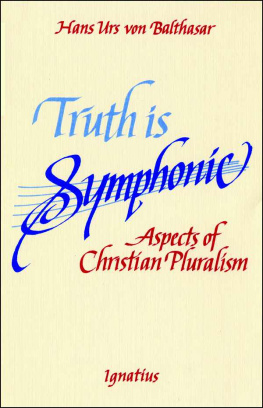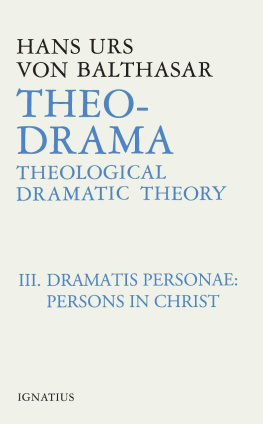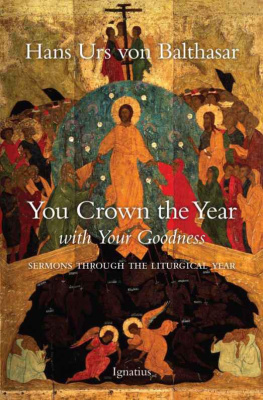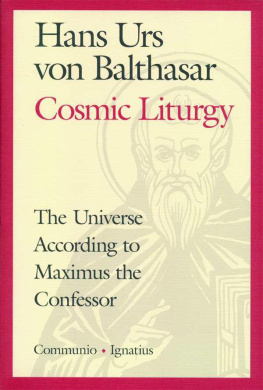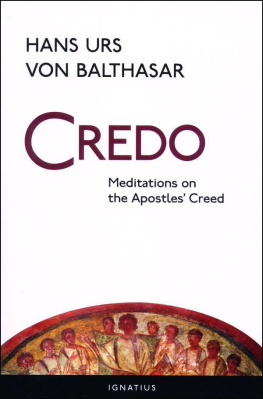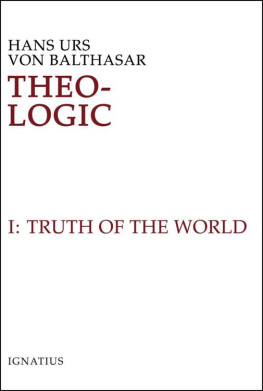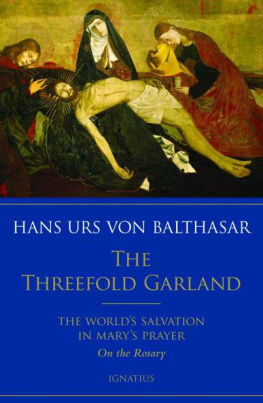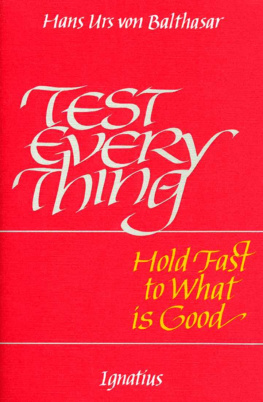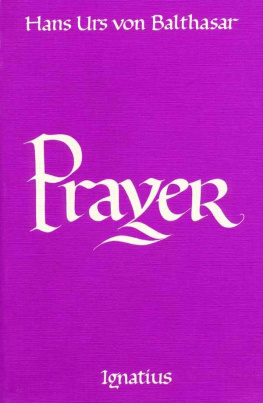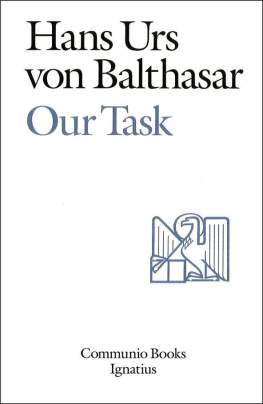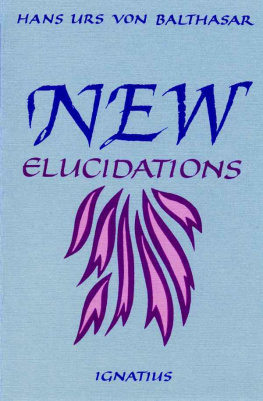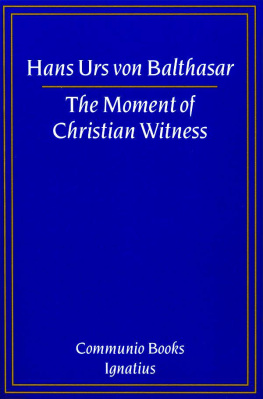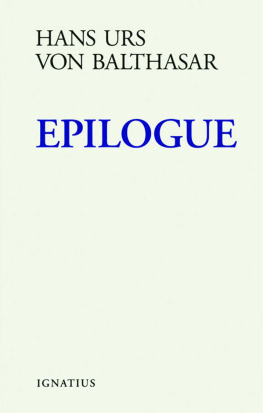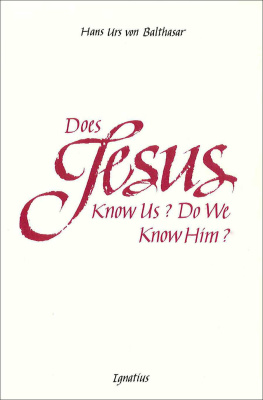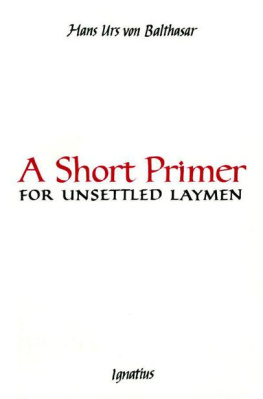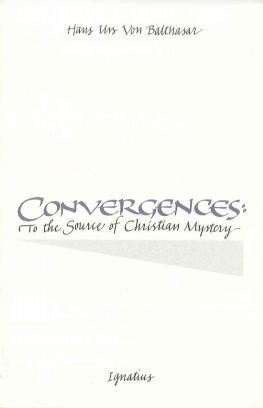Hans Urs von Balthasar - Truth is Symphonic
Here you can read online Hans Urs von Balthasar - Truth is Symphonic full text of the book (entire story) in english for free. Download pdf and epub, get meaning, cover and reviews about this ebook. year: 1987, publisher: Ignatius Press, genre: Religion. Description of the work, (preface) as well as reviews are available. Best literature library LitArk.com created for fans of good reading and offers a wide selection of genres:
Romance novel
Science fiction
Adventure
Detective
Science
History
Home and family
Prose
Art
Politics
Computer
Non-fiction
Religion
Business
Children
Humor
Choose a favorite category and find really read worthwhile books. Enjoy immersion in the world of imagination, feel the emotions of the characters or learn something new for yourself, make an fascinating discovery.
- Book:Truth is Symphonic
- Author:
- Publisher:Ignatius Press
- Genre:
- Year:1987
- Rating:4 / 5
- Favourites:Add to favourites
- Your mark:
- 80
- 1
- 2
- 3
- 4
- 5
Truth is Symphonic: summary, description and annotation
We offer to read an annotation, description, summary or preface (depends on what the author of the book "Truth is Symphonic" wrote himself). If you haven't found the necessary information about the book — write in the comments, we will try to find it.
Truth is Symphonic — read online for free the complete book (whole text) full work
Below is the text of the book, divided by pages. System saving the place of the last page read, allows you to conveniently read the book "Truth is Symphonic" online for free, without having to search again every time where you left off. Put a bookmark, and you can go to the page where you finished reading at any time.
Font size:
Interval:
Bookmark:
Truth Is Symphonic
Hans Urs von Balthasar
Truth Is Symphonic
Aspects of Christian Pluralism
Translated by Graham Harrison
Ignatius Press San Francisco
Title of the German original :
Die Wahrheit ist symphonisch:
Aspekte des christlichen Pluralismus
1972 Johannes Verlag, Einsiedeln
Cover by Victoria Hoke Lane
With ecclesiastical approval
1987 Ignatius Press, San Francisco
All rights reserved
ISBN 978-0-89870-141-8
Library of Congress catalogue number 86-83131
Printed in the United States of America
Contents
a. Israel
b. God and his Word
c. Jesus Christ, the Word of God
d. The interpersonal Thou: an image and an approach
e. Truth as body
f. The heightened paradox
g. The organs of truth in the heightened paradox
h. Paradox and pluralism
i. The pluralism of world views
j. The Word of God in human speech
k. The criterion of dogma
l. Partial and total identification
m. Ethics
n. Conclusion
1. Church and world
2. Believing and doing
3. A God at hand, a God afar offthe absences of Jesus
4. Office and existence
5. Joy and the Cross
6. The three forms of hope
Prologue. Truth Is Symphonic
Symphony means sounding together. First there is sound, then different sounds and then we hear the different sounds singing together in a dance of sound. A bass trumpet is not the same as a piccolo; a cello is not a bassoon. The difference between the instruments must be as striking as possible. Each one keeps its utterly distinctive timbre, and the composer must write for each part in such a way that this timbre achieves its fullest effect. Bach is not the best example here, perhaps, adapting violin concertos for the harpsichord with only slight modification, but Mozart is the absolute master: his violin, horn or clarinet concertos always succeed in bringing out the pure essence of the instrument concerned. In the symphony, however, all the instruments are integrated in a whole sound. Mozart had this whole sound in his car to such an extent that, on occasion, he could write down the single instrumental line of an entire movement because he heard it within the sym-phony of all the parts. The orchestra must be pluralist in order to unfold the wealth of the totality that resounds in the composers mind.
The world is like a vast orchestra tuning up: each player plays to himself while the audience take their seats and the conductor has not yet arrived. All the same, someone has struck an A on the piano, and a certain unity of atmosphere is established around it: they are tuning up for some common endeavor. Nor is the particular selection of instruments fortuitous: with their graded differences of qualities, they already form a kind of system of coordinates. The oboe, perhaps supported by the bassoon, will provide a foil to the corpus of strings, but could not do so effectively if the horns did not create a background linking the two sides of this counterpoint. The choice of instruments comes from the unity that, for the moment, lies silent in the open score on the conductors podiumbut soon, when the conductor taps with his baton, this unity will draw everything to itself and transport it, and then we shall see why each instrument is there.
In his revelation, God performs a symphony, and it is impossible to say which is richer: the seamless genius of his composition or the polyphonous orchestra of Creation that he has prepared to play it. Before the Word of God became man, the world orchestra was fiddling about without any plan: world views, religions, different concepts of the state, each one playing to itself Somehow there is the feeling that this cacophonous jumble is only a tuning up: the A can be heard through everything, like a kind of promise. In many and various ways God spoke of old to our fathers by the prophets... (Heb 1:1). Then came the Son, the heir of all things, for whose sake the whole orchestra had been put together. As it performs Gods symphony under the Sons direction, the meaning of its variety becomes clear.
The unity of the composition comes from God. That is why the world was, is and always will be pluralist (andwhy not?will be so increasingly). Of course, the world cannot get an overall view of its own pluralism, for the unity has never lain in the world either formerly or now. But the purpose of its pluralism is this; not to refuse to enter into the unity that lies in God and is imparted by him, but symphonically to get in tune with one another and give allegiance to the transcendent unity. As for the audience, none is envisaged other than the players themselves: by performing the divine symphonythe composition of which can in no way be deduced from the instruments, even in their totalitythey discover why they have been assembled together. Initially, they stand or sit next to one another as strangers, in mutual contradiction, as it were. Suddenly, as the music begins, they realize how they are integrated. Not in unison, but what is far more beautifulin sym-phony.
Todays situation, which must be our starting point, is characterized by an impatient tugging at the framework of a unity that is felt to be a prison. Isnt it unjust that a melody is trapped within a triple fugue, and that the law of the fugue governs how it shall developand even determines its original shape? The melody wants to escape from this conditional existence, developing and singing untrammeled.
Nowadays, there is a powerful urge to break through to the fascinating figure of Jesus Christ, to grasp him as he was, untrammeled, stripped of the damaging association with an institutional Church, a pile of unintelligible dogmas, obsolete customs and ossified traditions. He is to emerge from the detritus of two thousand years history and stand before us in his original, simple, naked radiance. And at the very same time the science of exegesis is insisting that we can know about Jesus Christ only through the early Churchs confessions of faith, that the accounts of his life are partially formed by this faiththat is, that we shall never be able to remove the ecclesiastical garments from him. Since this is irrefutable, a second struggle begins: the Church, with its two thousand years of growth, its wealth of tradition, is to be disrobed, purified, simplified until the (surmised) glory of Jesus Christ begins to shine through in it. This implies putting a question mark over even the earliest of the primitive Churchs formulations of faith: are not they too a veil, an excrescence? Layer after layer of the onion is peeled away, and in the end the core is also gone.
But are not both attempts right, in some way? For surely the Church as a totality ought to be transparent, allowing Christ to shine through? Surely it should be nothing other than that? And if it no longer is, no wonder people try to get behind it to the essentials. On the other hand, if Jesus surrendered himself to death in order to make himself understood as a totality, from the yonder side of death, through his Resurrection and through appearing to his disciples and explaining himself to them, is it not clear that the Church is the place he himself has chosen, the place where he wishes to be present and accessible? What we call Gods Incarnation in Jesus of Nazareth only comes to its fulfillment in the community of believers, who are aware of having been commissioned to announce this Incarnation to the world and to bear witness to it and represent it before the eyes of the world. And no one can say when the first community begins to be incipiently Catholic. From the very beginning the structure of office is there, in Peter and extremely strongly in Paul; from the beginning Mary is there, praying in the midst of the community, the Mother who stood with John at the foot of the Cross. From the very beginning people are baptized; the bread is broken; sins are forgiven; the sick are healed; there are the laying on of hands, the issuing of detailed instructions, the institution of presbyters, the pronouncement of sacred judgments and the recourse to tradition. The various themes are already interrelated, attuned to each other; the fugue proceeds. We cannot wrench Christ loose from the Church, nor can we dismantle the Church to get to Christ. If we really want to hear something intelligible, we are obliged to listen to the entire polyphony of revelation. We cannot make Christ shine through the Church by destroying it or replacing it with forms of community of our own designing. The only way is for Church people to model themselves as closely as possible on the reality of the Churchwhich is Christs body and thus his bodily presence. On the other hand, it is utter folly to try to grasp Christ: he always slipped through the hands of those who wanted to seize him. He himself, in his entire reality, is only a transparency: He who has seen me, has seen the Father; He who confesses the Son has the Father also; Do not hold me, for I have not yet ascended to the Father. We learn his secret by allowing him to return to his origin. And the Spirit who proceeds from Father and Son, since he is neither Father nor Son but their reciprocal love, introduces us into this mystery. Even eternal Truth itself is symphonic.
Next pageFont size:
Interval:
Bookmark:
Similar books «Truth is Symphonic»
Look at similar books to Truth is Symphonic. We have selected literature similar in name and meaning in the hope of providing readers with more options to find new, interesting, not yet read works.
Discussion, reviews of the book Truth is Symphonic and just readers' own opinions. Leave your comments, write what you think about the work, its meaning or the main characters. Specify what exactly you liked and what you didn't like, and why you think so.

